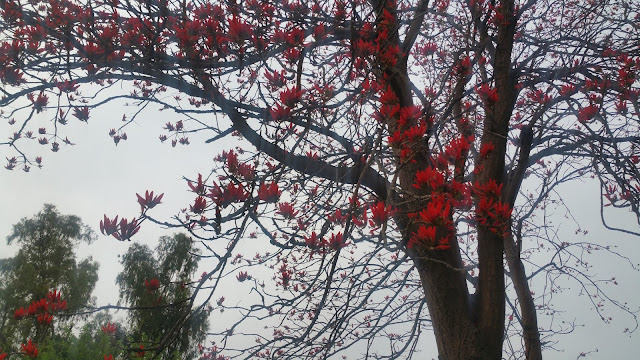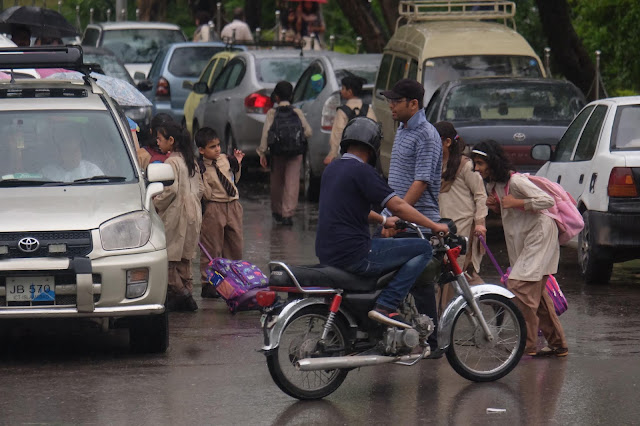Tuesday 23 April 2019
Wednesday 17 April 2019
Tuesday 16 April 2019
Those flying buttresses
Haresh forwarded "Notre dame Paris is burning!!!" on his Radio Haresh WhatsApp group (let me know if you want to join it, becoming a member is easy). It was a Forward. Another friend wrote "What did you do?" Haresh responded by saying " I put it on my bucket list and it burnt down! Tell me what do you want destroyed and I shall put it on my bucket list." The friend responded by saying "Any Trump Hotel."
There might be some truth to that. If a Trump Hotel or Golf Resort went up in flames, there might be a fair amount of celebration.
The Parisians were of course shocked and bereaved that evening. I watched minute-to-minute coverage of the burning of Notre Dame all evening on BBC (unfortunately, we don't get Al Jazeera on cable here in our sector in Islamabad so I wouldn't know if Al Jazeera also covered it back to back).
We are so used to the Western point of view that I hardly gave much thought to how much covering the burning of a cathedral was receiving and how much air time was being given to how the Parisians felt about it all.
"Terrible."
"Part of my life."
"Symbol of French culture and history."
"An inextricable part of Paris. Much older than the iconic Eiffel Tower."
"Universal iconic structure."
On and on the coverage went. One is so used to how much Western grief and news gets centre stage that one hardly thinks about it anymore.
The Parisians of course get even more special coverage, it seems. They are a very very special part of Europe.
But hang on, how is the Notre Dame cathedral a universal symbol? There are ancient structures way older and, much more fascinating that represent the world: the ancient Pyramids of Giza, Machu Pichu, Angor Watt, Lalibela, some ancient city in Zimbabwe, the libraries of Timbuktu, etc, etc. Proportionally, how does the small fake continent of Europe represent the world? And, morally, with its history of colonialism, how does Europe symbolise the world's heritage? I suppose we have to still keep up the pretence that Europe is a civilised and enlightened place.
Last year visiting Ethiopia was a revelation for me - I was completely moved and blown away by the ancient rock churches of Lalibela and the Ethiopian Christian art. It was as old as any European medieval art. I was incensed that we weren't even taught Ethiopian Christianity in our fancy Humanities class in high school. In this class, we pored over these gothic depressing and ugly-ass structures like Notre Dame and, their tympanums, naves and flying buttresses. No mention of Lalibela.
No sir, Notre Dame does not feel like a universal symbol of human history. It's ugly and scary. In my imagination, there are far more beautiful buildings and sites that I dream of visiting.
I also laughed a little at the notion that Notre Dame has a central position in French history and culture. Didn't we study in school that medieval cathedrals were built by poor peasants, hoping to get a ticket to heaven? These structures and even those I dream of visiting were built by poor folks. That is the material history of our world. So, how exactly is poor labour part of one's culture?
My best friend hit the ball out of the park in a WhatsApp conversation:
"Yep, built by poor peasants. But I'm so tired of the centering of the grand importance of white, European culture. Especially when the destruction of my culture is complete at the hands of these masters. Of course I can see the beauty, the loss. But guess what, there are other important things happening and, last time I checked, the French are still wreaking havoc with cultures around the world....they'll tax their former colonies more so they can pay for the restoration of this grand symbol of French, white superiority."
So yes, we all have to mourn and grieve for the French and European suffering. Professional mourners are at least paid but the world has to fulfil this service for free. Talk about unpaid emotional labour.
Monday 15 April 2019
Attending Mashal March
Isloo
folks, how was the weekend?
There
were a few events on offer this weekend break: 1) Rang E Baharan at Art and Craft Village
Islamabad in Shakarparian 2) ITP Family Gala in Fatima Jinnah Park and, 3) Face
Music Mela 2019 at the PNCA. There was also the Mashal March organised by the
Progressive Students Federation at the Islamabad Press Club. What to choose? Music
or standing up against extremism? You could choose between family fun in the
capital city of Pakistan or attend a march in the memory of a student who was
mercilessly lynched at a university campus? So what did you go for?
Seriously,
how many folks knew about Mashal March? And, how many citizens knew it was Mashal
Khan’s 2nd death anniversary? Did television media mark the day? I
fortunately found out about it through WDF, having joined it a few weeks ago.
Just
a day before, more than 20 people from the Hazara community were killed in a suicide bombing in Quetta.
This was of course addressed at the March with vehemence and indignation – in
fact, it was described as the continued open season on the Hazara community.
Where
is the vehemence and indignation I wondered? Is it limited to the folks who
were present at the March? I think there were about a 100 people at the March.
The speakers delivered fiery speeches. The protestors held up hard-hitting
placards. Everyone there was in unison. But where is everyone else, I wondered?
The music mela and family fun fairs?
From
recent memory, we have the white supremacist attacks
against 2 mosques in peaceful and idyllic New Zealand, whose Prime Minister
is now being hailed as the model of a true leader. See one piece here: 5
ways world leaders can learn from New Zealand prime minister Jacinda Ardern.
I believe Imran Khan issued a Tweet – whether or not he visited the Quetta
victims or has shown exemplary grace and leadership is doubtful. If correct
leadership were shown, the public would also follow: all public festivities should
be cancelled or postponed and, there would be organised support for victims. I wrote to one of my former colleagues and
dear Kiwi friend after the attacks and she wrote this to me on 18 March:
“NZers have responded as only we can with outpourtings of support for the muslim population with $4.2mill already raised for the families of those affected, offers of free transportation from hotels and private citizens, meals being prepared for families suffering, Govt and local council support for the preparation of grave sites and all related services - the list goes on and vigils happening all over the country.”
In
fact, I read that the Jewish
community from Pittsburgh raised money for the Christchurch victims. If
anyone remembers, there was a white supremacist attack in the US against a
synagogue and the local Muslim community responded with kindness and
solidarity.
Tragically,
terrorist attacks against the Hazara community have been too many to count. So,
it’s business as usual and, Balochistan might as well be in another part of the
world – the misery and suffering of a minority is irrelevant to a largely
apathetic and/or religiously brainwashed public.
The
stage of the Mashal Khan March seethed with anger and feelings of injustice.
One of Mashal Khan’s teachers spoke. Students spoke. Even Pervez Hoodbhoy
spoke! I was so excited to see him amongst the audience and then marching
alongside with us.
The
March reminded us that university campuses have become playing grounds for
hatred and violence. Khalid Hameed,
an English Lit professor was murdered by his student at a university in
Bhawalpur, a few weeks ago. Junaid
Hafeez was arrested on blasphemy charges in 2013 and languishes on death
row. Mashal Khan ‘s own horrific death
was caused by a mob of students on charges of blasphemy.
Almost
all the speakers reminded us that student
unions were banned during Zia ul Haq’s time and, their banning has been a
factor in the rising hatred on campuses.
And,
then there’s the foundation of it all, the rock on which lives are brutally
obliterated or banished to dungeons: the Blasphemy Law. One speaker
passionately demanded: but even if Mashal Khan had sinned, are you going to
kill him? And, what is it anyone’s business what I choose to or not choose to
believe in? He even on to say that we have to go back to the inception of
Pakistan which was created on the basis of religion, not the ideals of a Che
Guevera or a Fidel Castro.
These
are the angry sentiments that many of us feel – when confronted with religious
hatred and control in our own personal lives; thousands slaughtered in
sectarian attacks; the stifling religiosity of society; and, official state
rhetoric and narrative. We question the entire raison d’être of Pakistan, a
country forged on a communal identity. But can you really ask such dangerous
questions?
The
state of Mashal March asked these burning questions: about disappearances,
state violence, state sponsorship of banned outfits, the Army and ISI, etc.
I
was star struck with seeing Pervez Hoodbhoy, speaking with a fiery zeal about
the abysmal condition of education. What is the point of spending more money on
education if it’s merely producing a mob, he asked? (Later I met him and asked
him for a photograph with him. Who carries an autograph book anymore? We ask
for photographs.)
So,
how’d you spend your weekend, Islamabadis? Rocking at a mela or oppressed but
charged by attending the Mashal March?
PS.
It is quite staggering and monumental that 13 April is also the date of the Jallianwala
Bagh massacre.
Subscribe to:
Posts (Atom)



















































